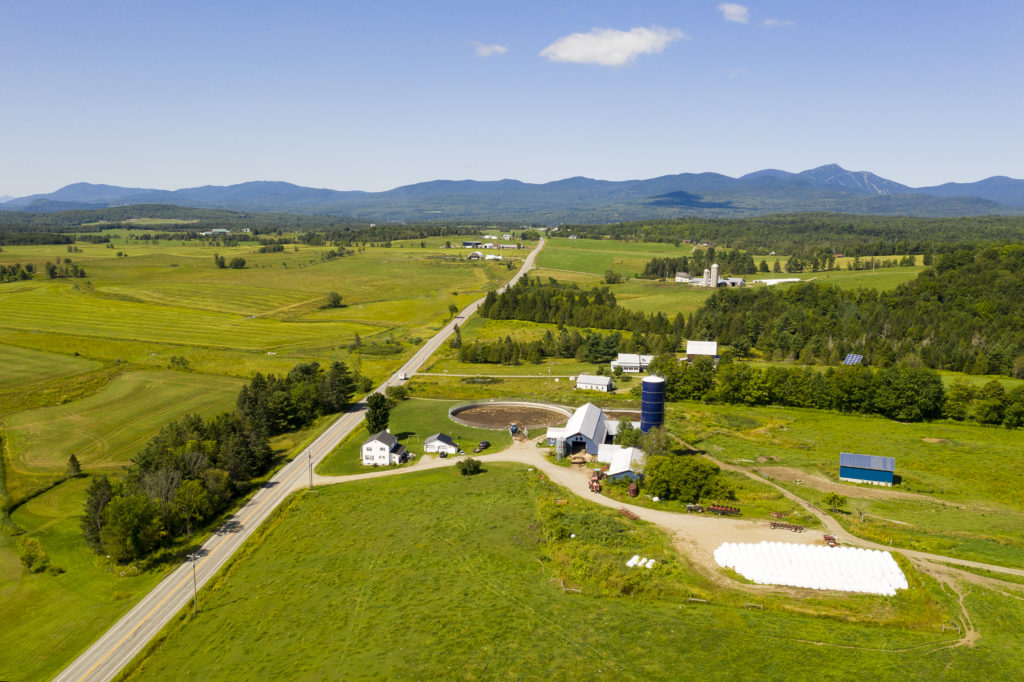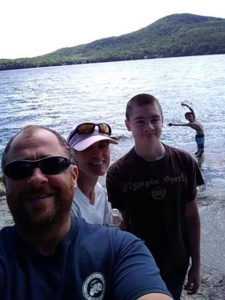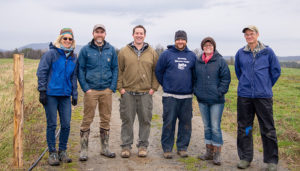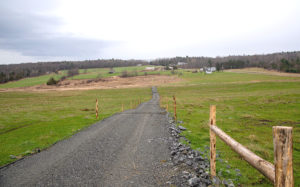It Takes a Conservation Partnership
How a small, organic Vermont dairy joined forces with local, state, and federal conservation partners to plan for the future.

An aerial view of the Marquis Organic Dairy in Newport, Vermont. Courtesy of Caleb Kenna.
Marquis Organic Dairy is located in the Upper Missisquoi Watershed, part of Vermont’s iconic, yet impaired, Lake Champlain Watershed. Just a stone’s throw from the Canadian border, the farm includes just under 250 acres of conserved land and organic pasture and hayland, in addition to 120 cows.

Marquis Organic Dairy is a family operation, run by Marc and Tiffany with sons Mason (15) and Jacob (11). Courtesy of the Marquis family.
Owned by Marc and and Tiffany Marquis, the couple purchased the farm from Marc’s uncle in 2011 and started their small, certified-organic dairy. Married since 2000, the couple is also raising two sons, ages eleven and fifteen. Raised on a conventional dairy, Marc notes that his father was very frugal. “It’s important to try to save when you can so it makes the tough times easier when they come,” said Marc. He also emphasized that organic is a lifestyle choice for their family, stating, “It’s better for the soil, and benefits animal health.” The farm includes prime agricultural soils, nearly 6,000 feet of road frontage, and is traversed by over 3,000 feet of two tributaries of the Mud Creek.
Faced with the uncertainty of the dairy industry, and learning the ropes of the State of Vermont’s Required Agricultural Practices (RAP’s), Marc turned to a host of conservation entities for guidance and support. “I knew I could do more,” he said. His conservation ethic, and the need to meet state regulations, motivated Marc to dive right into an alphabet soup of programs available from diverse entities. It takes a village, they say. Or in this case, a dedicated group of conservation partners who Marc says he has developed a relationship with, and a level of trust.
With the assistance of this partnership and their respective programs, the family installed a range of conservation practices to protect soil and water quality and permanently conserved two parcels, totaling 246 acres. The USDA-NRCS Regional Conservation Partnership Program (RCPP) was instrumental in pulling together the various players and program dollars.
The State of Vermont, via the Department of Environmental Conservation, was awarded a 16 million-dollar RCPP grant in 2015. The purpose was to provide financial and technical support to agricultural and forest landowners to help develop and implement projects that directly improved water quality in streams that flow into Lake Champlain. Specifically, this RCPP effort was aimed at helping small, conserved farms in the Lake Champlain Basin. “This was one of the first RCPP-Agricultural Land Easement (ALE) projects we tackled, and it’s been a great example of the team approach,” explains VHCB Agricultural Director Nancy Everhart.
Excess phosphorus from a variety of sources, including agriculture, has impaired the water quality of

The conservation partners with Marc Marquis, the owner/operator of Marquis Organic Dairy. Left to right: Nancy Everhart, Vermont Housing and Conservation Board (VHCB) Agricultural Director Nancy Everhart; Britt Haselton, Vermont Land Trust (VLT), Farm Project Director; Justin Michaud, Vermont Association of Conservation Districts (VACD), RCPP Conservation Planner; Marc Marquis, owner/operator of Marquis Organic Dairy in Newport, Vermont; Tina McGranaghan, NRCS Soil Conservation Technician; and Ben Gabos, VT Agency of Agriculture, Food, and Markets (VAAFM), CREP Coordinator.
Amy Overstreet / USDA-Natural Resources Conservation Service
Lake Champlain’s watersheds, such as the Upper Missisquoi where the Marquis Dairy is located. A new Total Maximum Daily Load (TMDL) for Lake Champlain was established in 2016. The TMDL is the maximum amount of a pollutant that a waterbody can receive and still meet water quality standards. In addition, Vermont’s required agricultural practices were strengthened to improve the quality of Vermont’s waters by reducing cropland erosion, sediment losses, and nutrient losses through improved farm management techniques, technical and compliance assistance, and where appropriate, enforcement. They establish nutrient, manure, and waste storage standards, make recommendations for soil health and establish requirements for vegetated buffer zones and livestock exclusion from surface water. The RAPs also created standards for nutrient management planning and soil conservation, including requiring that small farms annually certify compliance with the RAPs and develop and implement nutrient management plans. Marc wrote his own nutrient management plan after participating in an RCPP-funded workshop sponsored by VACD and led by staff from the University of Vermont Extension. “The workshop enables farmers to take control and really learn the nuts and bolts of nutrient management planning,” explained VACD RCPP Conservation Planner Justin Michaud.
RCPP enabled the installation of conservation practices through the Environmental Quality Incentives Program (EQIP) including:
-Trails and walkways
-Composting facility
-Critical area planting
-Fencing
-Heavy use protection area
-Mulching
-Roofs and covers
-Subsurface drain
-Waste transfer
-Grazing plan
-Stream crossing
Marc says that the trails and walkways have been particularly useful. “It’s easier on me, easier on the cows, and hoof problems disappear,” he explained.
In order to protect water quality and improve wildlife habitat, land along the streambanks of unnamed Missisquoi River tributaries was removed from production and enrolled in the Conservation Reserve Enhancement program (CREP) as riparian forest buffers. With assistance through CREP and the Partners for Fish and Wildlife Program, 5,698 trees and shrubs were planted to create 14 acres of buffer, all with a minimum width of 50’. “Restoring forested buffers on tributaries of this scale may not seem like a big deal, but, collectively, the health of these smaller headwater streams determines the water quality of the larger streams and rivers downstream, so projects like this are a key piece of the puzzle to improve water quality in the Missisquoi basin,” explained CREP planner Ben Gabos.

Trails and walkways installed through the Environmental Quality Incentives Program (EQIP) improve animal health and help prevent soil erosion and protect water quality.
Amy Overstreet / USDA-Natural Resources Conservation Service
Finally, the lasting impact of this tremendous conservation work, including the fifty-foot CREP riparian buffers, will be protected through permanent agricultural land easements which prevent conversion of productive working lands to non-agricultural uses. Spearheaded by VHCB and VLT, the Marquis’ conserved two parcels, their 122-acre home farm parcel and a 124-acre cropland parcel, through the NRCS Agricultural Conservation Easement Program (ACEP). This acreage included 23 acres of prime farmland and 161 acres of farmland of statewide importance. Prime means that the farm includes land that has the best combination of physical and chemical characteristics for producing food, feed, forage, fiber, and crops. The statewide significant delineation includes land that has certain limitations such as excessive slope or erosion, wetness, or is prone to flooding.
During a recent tour of the farm to review progress, members of the partnership agreed that it was Marc’s patience and diligence that helped make this project a success. “I have been impressed with the family’s receptive and good-natured approach to working with the conservation partnership,” noted VLT’s Farm Project Director Britt Haselton.
The power of partnership is at work at the Marquis farm, where conservation, hard work, and dedication are paving the way for a bright future and a healthy farm.

